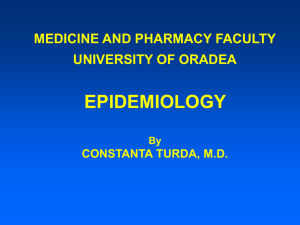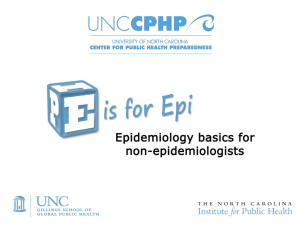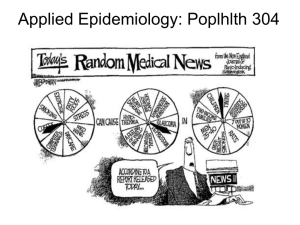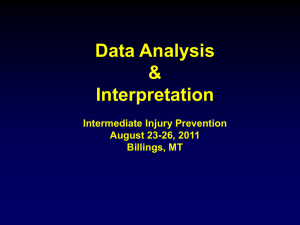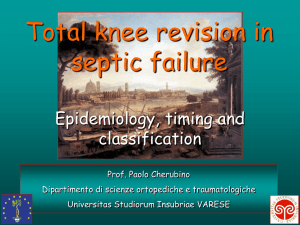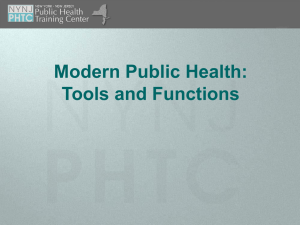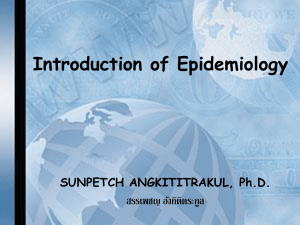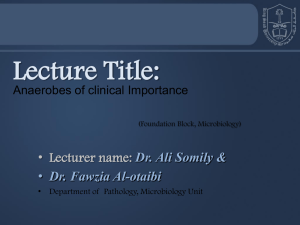Lec 7 Principles of disease epidemiology
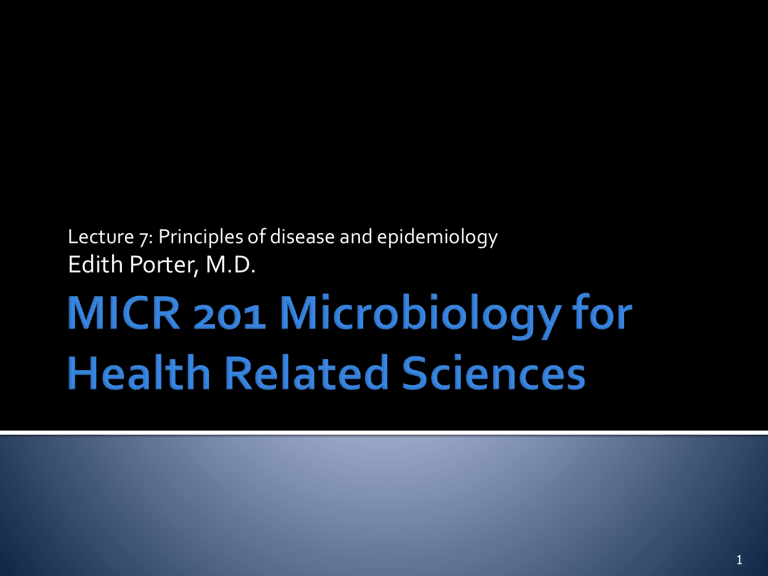
Lecture 7: Principles of disease and epidemiology
Edith Porter, M.D.
1
Case study (Video)
Pathology, infection, and disease
Normal microbiota
Etiology of infectious diseases
▪ Koch’s postulates and exceptions
Classifying infectious diseases
Patterns of disease
Spread of infections
Nosocomial infections
Emerging infectious diseases
Epidemiology
2
Pathology
Scientific study of disease
Etiology
Study of the cause of a disease
Pathogenesis
Pathos = Suffering
Logos = Science
Development of disease
Infection
Colonization of the body by microbes that are not routinely present at this site
Disease
A change from state of health
HIV pos.
AIDS
Tuberculin pos.
Tuberculosis
Abnormal state in which the body is not function normally
Pathogen
Causes disease in a healthy adult
Expresses special virulence or pathogenicity factors
Is not part of normal flora
Opportunist
Does not cause disease under normal conditions
Causes disease at local or systemic breaches of host defense
Often part of normal flora
Cooperation
Different microbes together cause disease
Body is sterile in utero
Colonized within hours after birth
Lactobacilli
Staphylococci
Outnumber body cells by at least 10– fold
Normal flora does not cause disease under normal conditions
Transient microbiota
present for a relatively short period of time (days, weeks, or months)
Resident microbiota
Normal microbiota permanently colonizing the host
6
Skin
Eye
Body site
Nasooropharynx
Microbiota
Gram+
Sparse (gram+)
Gram+
Gram- anaerobes
Lead microorganism
Staphylococcus epidermidis
Neisseria spec.
a
-hemolytic streptococci
Haemophilus spec.
Stomach
Small intestine
Large intestine
Urethra
Vagina
Sparse
Sparse
Facultative and anaerobic gram+
Facultative and anaerobic gram-
Gram+
Some anaerobic gram -
Gram+
Some anaerobic gram -
Enterococcus faecalis
E. coli, Clostridium species
Male: Mycobacterium smegmatis
Lactobacillus spec.
Low numbers of Candida albicans can be found everywhere
Nose Stomach Intestine
Trichomonas vaginalis is considered a pathogen
Trichomonas hominis is normal flora in large intestine
Normal microbiota
Competes with potential pathogens for nutrients
Directly inhibits potential pathogens
▪ Lactobacilli: lactic acid, low pH
▪ Bacteriocins
Produces some vitamins (K, B)
Candidiasis after antibiotic treatment
Clostridium difficile diarrhea after antibiotic therapy http://www.health-res.com/EX/07-28-04/37FF1.jpeg
Pseudomembranous enterocolitis caused by C. difficile
Administration of viable bacteria to the benefit of human health
Lactobacilli, Streptococci,
Bifidobacteria
Withstand HCl, bile salts
Adhere to host intestinal mucosa
Produce useful enzymes or physiological end products
Restore normal microbiota
Prophylactic application
Lactobacilli to prevent development of antibiotic associated diarrhea
Therapeutic applications
Supplementary therapy in chronic
UTI with E. coli
Robert Koch established the “Golden Rule” to positively identify a microorganism as the cause of an infectious disease
1.
The same pathogen must be present in every case of disease and not in the healthy one.
2.
The pathogen must be isolated from the diseased host and grown in pure culture.
3.
The pathogen from the pure culture must cause same disease when it is inoculated into a healthy susceptible host.
4.
The same pathogen must be isolated from the inoculated host in pure culture.
Microorganism cannot be grown in the laboratory in/on artificial culture media
Utilization of animals or eggs for propagation
One disease can be caused by multiple microorganisms
E. g. nephritis
One microorganism can cause multiple disease conditions
15
http://2.bp.blogspot.com/_ayDfkQkrVmU/TFJ0clyjbWI/AAAAAA
AAAIs/5oG7IQ7UuHI/s1600/post+mortem+Dis+alpacas.JPG
http://www.path.cam.ac.uk/Abnormal/TB_Tuberculosi s/TB_Tuberculosis/SN_Spine/A_TB_TB_SN_02.jpg
16
Microorganism cannot be grown in the laboratory in/on artificial culture media
Utilization of animals or eggs for propagation
One disease can be caused by multiple microorganisms
E. g. nephritis
One microorganism can cause multiple disease conditions
M. tuberculosis can affect skin, lungs, bones etc.
No host other than humans
E.g. HIV
More than one microorganisms cause one infection
Polymicrobial infections such as abscess caused by anaerobic bacteria
17
Symptom
A change in body function that is felt by a patient as a result of disease
Sign
Often used interchangeable
A change in a body that can be
measured or observed as a result of disease
Syndrome
A specific group of signs and symptoms that accompany a disease
Communicable disease
A disease that is spread from one host to another
▪ Example: Tuberculosis
Contagious disease
A disease that is easily spread from one host to another
▪ Example: Chicken pox
Noncommunicable disease
A disease that is not transmitted from one host to another
▪ Example: Tetanus
Incidence
Number of people in a population who develop a disease during a particular time period
Includes new cases
Prevalence
Number of people in a population having a specific disease at a given time
Includes old a new cases
Sporadic disease
Disease that occurs occasionally in a population
Endemic disease
Disease constantly present in a population
Epidemic disease
Disease acquired by many hosts in a given area in a short time
Pandemic disease
Worldwide epidemic
21
Acute disease
Symptoms develop rapidly
Chronic disease
Disease develops slowly
Subacute disease
Symptoms between acute and chronic
Latent disease
Disease with a period of no symptoms when the infectious agent is inactive
Herd immunity
Many immune people are present in a population preventing the spread of a disease
Herd Immunity
Often contagious during incubation and prodormal period!!
Local infection
Pathogens limited to a small area of the body
Systemic infection
An infection spread through the body (via blood or lymphatic system)
Focal infection
Systemic infection that began as a local infection
Bacteremia
Bacteria in the blood
Septicemia
Spread of bacteria through the blood with organ manifestation
Toxemia
Toxins in the blood
Fungemia
Fungi in the blood
Viremia
Viruses in the blood
Common cause for bacteremia:
Coagulase negative staphylococci colonizing i.v. catheter
Factors that make the body more susceptible to disease
Primary and secondary infection
▪ Acute infection that causes the initial illness and predisposes to a secondary, often opportunistic infection
Male versus female
Genetic background
Climate and weather
Nutrition
Lifestyle
Occupation
Pre-existing illness
Example:
Influenza and
Haemophilus influenzae
Tick
Continual sources of the disease organisms
Humans — AIDS, gonorrhea
Carriers may have inapparent infections or latent diseases
Animals — Rabies, Lyme disease
Some zoonoses may be transmitted to humans
Nonliving — Botulism, tetanus
Soil
Lyme Disease:
Skin manifestation
Borrelia burgdorferi
28
Direct
Requires close association between infected and susceptible host
Includes fecal-oral
Indirect
Spread by fomites
Droplets
Transmission via airborne droplets
Inanimate reservoir
Food
Water
Vectors
Arthropods
▪ Fleas : plague
▪ Ticks: Lyme disease
▪ Mosquitoes: malaria
Mechanical
Biological : some part of the development of the microbe takes place in the vector
Acquired during a hospital stay
Source is hospital
5-15 % of all hospital patients affected
Diseases that are new, increasing in incidence, or showing a potential to increase in the near future
Appearance of new strains by genetic recombination
E. coli O157:H7
Avian influenzavirus H5N1
Evolution of new serovars
V. cholerae O139
Inappropriate use of antibiotics and pesticides
Antibiotic resistant strains
Multidrug resistant M. tuberculosis
Global warming and weather changes
Hantavirus pulmonary syndrome
Spread of known diseases by modern transportation
Cholera
Ecological Disaster
Coccidioidomycosis after
Northridge earthquake
Failures in public health
Missed immunizations
As told by CDC …
It seems that one of their scientists, on first arriving at CDC from a clinical practice, found himself somewhat unsure of what epidemiology was all about, so he sought an answer down the street at Emory University.
The first person he asked was a medical student , who told him that epidemiology was " the worst taught course in medical school ."
The second, a clinical faculty member , told him epidemiology was " the
science of making the obvious obscure.
"
Finally, knowing that statistics are important to epidemiology, he asked a statistician , who told him that epidemiology is " the science of long division" and provided him with a summary equation. Giving up on finding a real answer, he returned to CDC.
On the way, however, he decided to try one more time. He stopped a native Atlantan who told him that epidemiology was " the study of skin
diseases.
”
Discipline that find answers to When? Where? How transmitted?
Study—Epidemiology is the basic science of public health. It's a highly quantitative discipline based on principles of statistics and research methodologies.
Distribution—Epidemiologists study the distribution of frequencies and patterns of health events within groups in a population. To do this, they use descriptive epidemiology, which characterizes health events in terms of time, place, and person.
Determinants—Epidemiologists also attempt to search for causes or factors that are associated with increased risk or probability of disease.
This type of epidemiology, where we move from questions of "who,"
"what," "where," and "when" and start trying to answer "how" and "why," is referred to as analytical epidemiology.
Health-related states—Epidemiology as it is practiced today is applied to the whole spectrum of health-related events, which includes chronic disease, environmental problems, behavioral problems, and injuries in addition to infectious disease.
Populations—One of the most important distinguishing characteristics of epidemiology is that it deals with groups of people rather than with individual patients.
Control—Epidemiological data steers public health decision making and aids in developing and evaluating interventions to control and
prevent health problems. This is the primary function of applied, or field, epidemiology.
John Snow
Cholera outbreaks in London 1848-1849
Ignaz Semmelweis
Childbed fever (puerperal sepsis) 1846 - 1848
Florence Nightingale
Epidemic typhus 1858
Cholera epidemics in London
1846 – 1849
Snow analyzed the death records and interviewed survivors
Created map
Most individuals who died of cholera used water from Broad street pump
Survivors did not drink water but beer instead or used another pump
Identified the Broad street water pump as likely source
After closing this pump number of cholera cases dropped significantly
Mandatory hand washing introduced
Recorded statistics on epidemic typhus in English civilian and military populations
Published a 1000 page report in
1858
Statistically linked disease and death with poor food and unsanitary conditions
Novel graph: coxcomb chart or polar area diagram chart
▪ Fixed angle and variable radii
Resulted in reforms in the British
Army
Nightingale became the first female member of the Statistical
Society
Experimental
Epidemiologist is in control of the circumstances at the beginning of the study
Begins with a hypothesis
Prospective study that usually involves controls
Example: Semmelweis’ study; vaccine efficacy trials
Observational (or descriptive)
Epidemiologist is not in control of the circumstances at the beginning of the study
Descriptive
▪ Collect data about affected individuals, the places and the periods in which disease occurred (Who? Where? When?)
▪ Typically retrospective
▪ E.g. Snow’s study
Analytical
▪ Analyzes a particular disease to determine its probable cause (How? Why?)
▪ Case control method – look for factors that might have preceded the disease
▪ Cohort method – study of two populations, one having had contact with the disease agent and the other that has not
▪ E.g., Nightingale’s study
